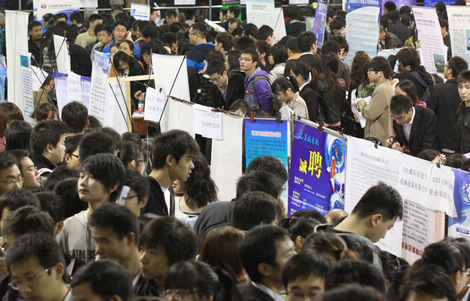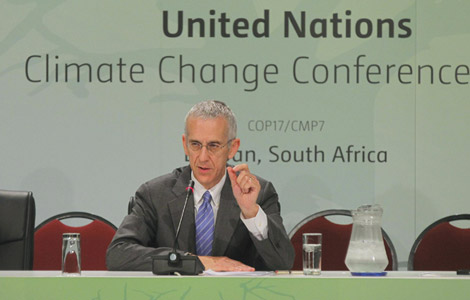China issues 1st white paper on foreign trade
Updated: 2011-12-07 10:47
(Xinhua)
|
|||||||||||
The Chinese government on Wednesday issued a white paper on foreign trade, highlighting the country's achievements in boosting foreign trade and its contribution to the world economy.
The paper was issued by the Information Office of the State Council on the occasion of the 10th anniversary of China's World Trade Organization (WTO) accession.
"The past decade has witnessed the proportion of China's trade volume in the world's total rise from 4.3 percent to 10.4 percent, " said Chong Quan, deputy representative for China's international trade talks and former assistant to the minister of commerce, at a press conference on Wednesday.
The total value of China's imports and exports reached $2.97 trillion in 2010, 144 times as much as in 1978 when the country initiated its reform and opening up policy, averaging an annual growth of 16.8 percent, according to the white paper.
Chong said the country's imports would reach $8 trillion in the next five years according to estimates of the Ministry of Commerce (MOC).
The fast growing foreign trade has not only bolstered China's economic growth but also contributed to the world economy. In the past decade, China's gross domestic product rose to the second largest in the world with an average annual growth of 11 percent, said Chong.
Meanwhile, the country's imports averaged $750 billion annually during the past 10 years, creating more than 14 million jobs for its trading partners, he said, adding that the country had made prominent contributions to the global economic recovery.
In addition, he pointed out that China has been the largest export market for least developed countries since 2008.
The white paper said that by July 2010 China had granted zero-tariff treatment on over 4,700 commodities from 36 least developed countries that have diplomatic ties with China. The zero-tariff commodities accounted for 60 percent of the total imports from those countries.
As for exports, China will look to export more to developing countries because demand from developed nations is unlikely to improve, said Wang Shouwen, head of the MOC's Foreign Trade Department.
He said the country will face "severe challenges" next year as demand from Europe and US will not significantly recover and domestic production costs will continue to rise.
The country's export growth had slowed in the past two months due to weakening international demand. Rising labor costs, the appreciation of the yuan and more expensive crude materials have also been hurting the country's exporters.
Wang said China's exporters will focus more on developing countries. The country will also quicken the pace of readjusting its foreign trade structure, support brand-building, research and development, and create more sales channels for companies.
"With these efforts, we believe China's exports will register good growth next year," he said.
BALANCED, SUSTAINABLE GROWTH
The 35-page white paper noted that the country's trade surplus is a result of globalization and the international division of labor.
"It is the country's different level and status of participation in the international division of labor in manufacturing and the services industry that leads to China's big surplus in goods trade but a long-term deficit in services trade," the paper said.
In 2010, China's surplus in trade in goods accounted for 6.1 percent of the total import and export volume and 3.1 percent of the GDP. Of the nine nations with the largest trade balances (favorable or unfavorable), China was not high up in the league table in terms of the two ratios, according to the paper.
"With the transfer of large numbers of labor-intensive processing and assembling sectors to China from Japan, Singapore and other nations and regions, their surpluses with the United States and Europe were also transferred to China," the paper said.
This explains why China runs trade surpluses with the US and Europe, but has long-term deficits with Japan, Republic of Korea, ASEAN and other major intermediate producers.
The paper noted that China's surplus in trade in goods mainly comes from foreign-invested enterprises and processing trade. Last year, the surplus created by foreign-invested enterprises reached $124.3 billion, accounting for 68.4 percent of the total surplus of China's trade in goods.
Meanwhile, some developed countries still impose restrictions on high-tech exports to China, which also has contributed to the country's large trade surplus, the paper said.
The sharp increase in surplus has resulted in an increasing number of trade frictions between China and its trading partners, as well as persistent pressure on the RMB to appreciate.
"A large number of anti-dumping and countervailing investigations targeting China were driven by trade protectionism. In some cases, they involved Chinese enterprises' lack of understanding of trade rules and inappropriate operation, " said Li Chenggang, another MOC official.
He expected that trade frictions would be inevitable in the medium and longer term as China has already topped the world in the number of trade remedy cases, calling for rational cooperation in dealing with disputes.
According to the white paper, the Chinese government has adopted a series of policies to curb "overheated" surplus growth, including moves to expand domestic demand, increase imports, adjust export tax rebates, restructure and upgrade the processing trade and reform the yuan exchange rate mechanism,
Regarding the yuan, Chong said the exchange rate of the yuan is aligned to market demand and is not being manipulated by the government.
"The recent depreciation of the yuan is a good phenomenon. It demonstrates that China's foreign exchange rate is not controlled by the government, as some have claimed," Chong said.
He said the currency's appreciation or depreciation is responsive to market demand and will float freely with market changes.
During the period from the exchange rate reform in July 2005 to the end of August 2011, the nominal exchange rate of the yuan against the dollar appreciated by about 30 percent, said the white paper.
Due to the nation's efforts to promote balanced foreign trade, China's surplus in trade in goods has been on a steady decline since 2009, and the proportion of surplus in the total import and export trade volume and the GDP has also dropped since 2008, said the paper.
The paper also said the nation will make new adjustments to turn foreign trade from scale expansion to quality and profit improvement, and from reliance on low-cost advantage to enhancement of its comprehensive competitiveness.
Intellectual property protection and product quality are among two other pressing issues the government will seek to address in its pursuit of sustainable growth.
China will have to make "arduous efforts" and a relatively longer period of time to transform into a major trade country in terms of competitiveness, said the paper.
Hot Topics
HIV/AIDS, Egypt protest, Thanksgiving, climate change, global economic recovery, home prices, high-speed railways, school bus safety, Libya situation, Weekly photos
Editor's Picks

|

|

|

|

|

|







